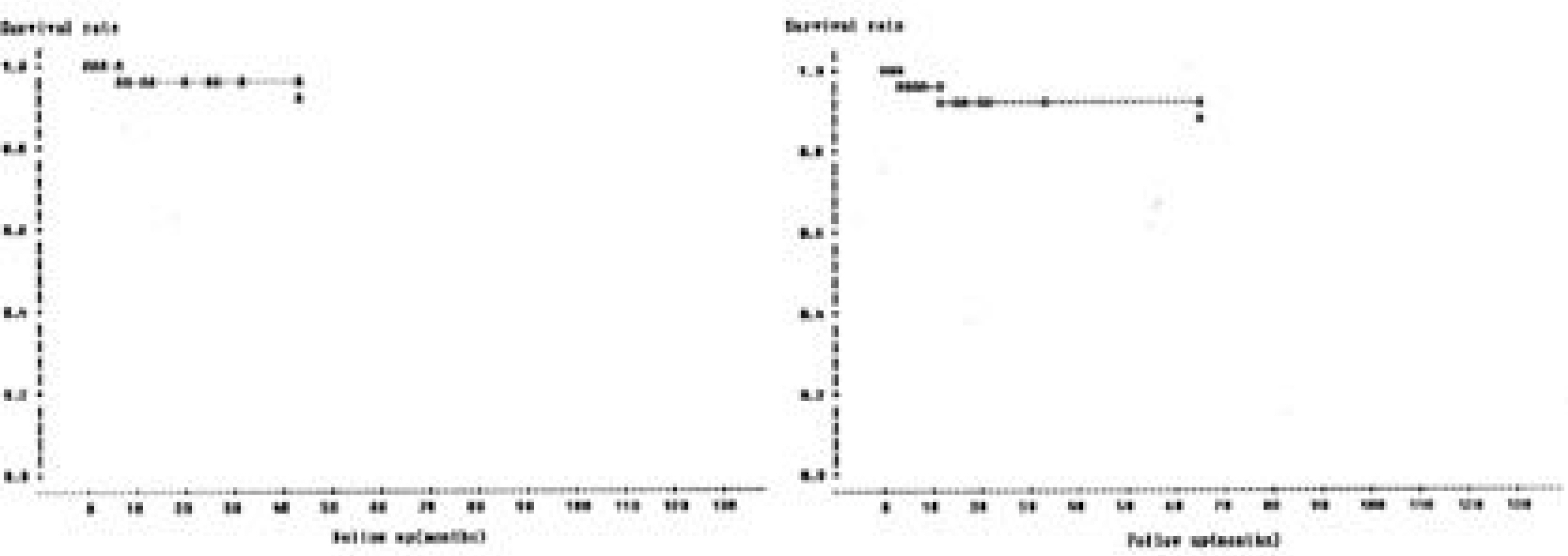J Korean Soc Spine Surg.
2002 Jun;9(2):157-163.
Metal Failure of Pedicle Screw System
- Affiliations
-
- 1Department of Orthopaedic Surgery, College of Medicine, Dong-A University, Busan, Korea.
Abstract
-
STUDY DESIGN: The metal failure of pedicle screw system followed by posterolateral or posterior fusion used in variable cases(spine fracture, degenerative disorder of spine, deformity of spine) was analyzed retrospectively.
PURPOSE: The goal of this study was to analyze frequency and clinical consequence of pedicle screw fixation system failure in the treatment of different etiology(spine fracture, degenerative disorder, deformity of spine) and to evaluate affected factors in metal failure.
MATERIALS AND METHODS
We performed survivorship analysis on 442 patients treated with pedicle screw system from September 1990 to December 1999. The average follow-up period was 54 months(from 18 months to 129 months). As affected factors, some variables such as etiology, kinds of system and extent of fusion were subjected to analyzed their influence on metal failure. We also performed analysis about relationship between metal failure and clinical results. We defined the metal failure as 1) breakage of screw or rod 2) screw bending above 5 degrees 3) dissociation of rod-screw coupling system and 4) screw pull out from vertebral body or pedicle.
RESULTS
We found out 33 cases of metal failure: among 2786 screws, 41 screws had a problem. The metal failure rate was different between each etiology ; 12 cases in fracture(10%), 21 cases in degenerative disorder(6.9%). There was also difference between a kinds of implants; 13 cases in side assembling type(5.4%), 20 cases in back open type(10.5%). However, there were no difference according to extent of fusion; 6 cases in one segment(6.9%), 21 cases in two segments(8.1%), 6 cases in more than three segments(6.3%). Among the overall patients with metal failure (33 cases), only eight patients were complaint significant symptoms. And three of this eight patients were improved after reoperation The mean interval to metal failure was 14.4 months from operation.
CONCLUSION
The metal failure was more common in spine fracture(p<0.05) and back open type pedicle system(p<0.05). However, there was no relationship with extent of fusion(p>0.05). And metal failure did not significantly affect the clinical results(p>0.05).
Keyword
MeSH Terms
Figure
Reference
-
1). Boos N, Marchesi D, Aebi M. Survivorship analysis of pediculat fixation system in the treatment of degenerative disorders of the lumbar spine: A comparison of Cotrel-Dubousset instrumentation and the AO internal fix - ator. J. of Spinal Disorder. Vol 5:No.(4):403–409. 1992.2). Ebelke DK, Asher MA, Neff JR, Kraker DP. Survivorship analysis of VSP spine in treatment of thora columbar and lumbar burst fraction Spine. 16(Suppl.):184–189. 1991.3). McAfee PC, Farey ID, Sutterlin CE, Gurr KR, Wrden KE, Cunningham BW. The effect of spinal implant rigidity on vertebral bone density: a canine model. Spine. 16(Suppl.):190–197. 1991.4). McAfee PC, Weiland DJ, Carlow JJ. Survivorship analysis of pedicle spinal instrumentation. Spine. 16(Suppl.):422–427. 1991.
Article5). McAfee PC, Weiland DH. Survivorship analysis of pedicle fixation systems. Presented at the 25th Annual Meeting of the. Scoliosis Research Society;Honolulu Hawaii. 1990.6). Ohlin A, Karlsson M, Dupe H, Harsserius R, Red-lund-Hohnell I. Complications after transpedicular stabilization of the spine. Spine. 19:2774–2779. 1994.
Article7). Roy-Carmille R, Saillant G, Berteaux D, Salgodo V. Osteosynthesis of thoracolumbar spine fractures with metal plates screwed through the vertebral pedicles. Reconstr. Surg. Traumatol. 15:2. 1976.8). Roy-Camille R, Saillant G, Mazel C. Plating or thoracic, thoracolumbar and lumbar injuries with pedicle screw plates. Ortho. Clin. North Am. 17:147–159. 1986.9). Shin BJ, Kim KJ, Kim ST, Kim YI. Survivorship analysis of pedicle screw fixation: J. of Korean Spine Society. Vol. 6:No. (3):355–361. 1999.10). Steffee A, Biscup R, Sitkowski D. Segmental spine plates with pedicle screw fixation: A new interval fixation device for disorders of the lumbar and thoracic spine. Clin. Ortho. 203:45. 1986.
- Full Text Links
- Actions
-
Cited
- CITED
-
- Close
- Share
- Similar articles
-
- Predictability of Magerl & McCormack's Load Sharing Classification on the Metal Failure after Pedicle Screw Fixation in the Thoracolumbar Spine Fracture
- Metal Failure in patients with Short-segmental Pedicle Screw Fixation and Fusion for Degenerative Lumbar Disease: Comparison Monoaxial with Polyaxial Screw
- Unilateral versus Bilateral Pedide Scrwe Fixation in Lumbar Spinal Fusion
- Technical aspects of rod-insertion forceps (persuader) application in reducing construct failure after lumbar spine fusion surgery: a biomechanical cadaveric study in Germany
- A Case of Pedicle Screw Loosening Treated by Modified Transpedicular Screw Augmentation with Polymethylmethacrylate








